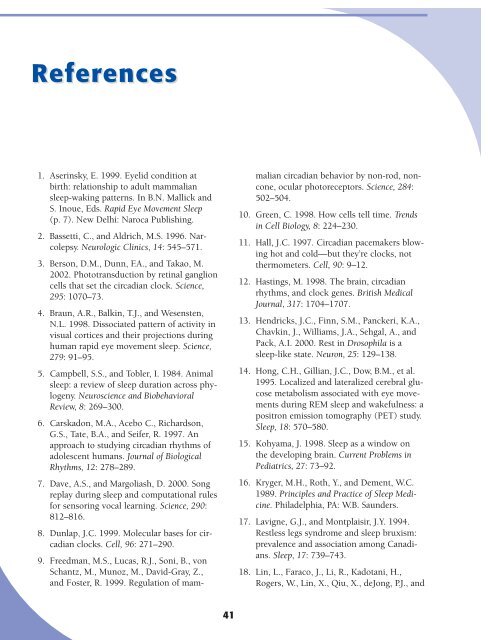Biological - NIH Office of Science Education - National Institutes of ...
Biological - NIH Office of Science Education - National Institutes of ...
Biological - NIH Office of Science Education - National Institutes of ...
Create successful ePaper yourself
Turn your PDF publications into a flip-book with our unique Google optimized e-Paper software.
References<br />
1. Aserinsky, E. 1999. Eyelid condition at<br />
birth: relationship to adult mammalian<br />
sleep-waking patterns. In B.N. Mallick and<br />
S. Inoue, Eds. Rapid Eye Movement Sleep<br />
(p. 7). New Delhi: Naroca Publishing.<br />
2. Bassetti, C., and Aldrich, M.S. 1996. Narcolepsy.<br />
Neurologic Clinics, 14: 545–571.<br />
3. Berson, D.M., Dunn, F.A., and Takao, M.<br />
2002. Phototransduction by retinal ganglion<br />
cells that set the circadian clock. <strong>Science</strong>,<br />
295: 1070–73.<br />
4. Braun, A.R., Balkin, T.J., and Wesensten,<br />
N.L. 1998. Dissociated pattern <strong>of</strong> activity in<br />
visual cortices and their projections during<br />
human rapid eye movement sleep. <strong>Science</strong>,<br />
279: 91–95.<br />
5. Campbell, S.S., and Tobler, I. 1984. Animal<br />
sleep: a review <strong>of</strong> sleep duration across phylogeny.<br />
Neuroscience and Biobehavioral<br />
Review, 8: 269–300.<br />
6. Carskadon, M.A., Acebo C., Richardson,<br />
G.S., Tate, B.A., and Seifer, R. 1997. An<br />
approach to studying circadian rhythms <strong>of</strong><br />
adolescent humans. Journal <strong>of</strong> <strong>Biological</strong><br />
Rhythms, 12: 278–289.<br />
7. Dave, A.S., and Margoliash, D. 2000. Song<br />
replay during sleep and computational rules<br />
for sensoring vocal learning. <strong>Science</strong>, 290:<br />
812–816.<br />
8. Dunlap, J.C. 1999. Molecular bases for circadian<br />
clocks. Cell, 96: 271–290.<br />
9. Freedman, M.S., Lucas, R.J., Soni, B., von<br />
Schantz, M., Munoz, M., David-Gray, Z.,<br />
and Foster, R. 1999. Regulation <strong>of</strong> mam-<br />
malian circadian behavior by non-rod, noncone,<br />
ocular photoreceptors. <strong>Science</strong>, 284:<br />
502–504.<br />
10. Green, C. 1998. How cells tell time. Trends<br />
in Cell Biology, 8: 224–230.<br />
11. Hall, J.C. 1997. Circadian pacemakers blowing<br />
hot and cold—but they’re clocks, not<br />
thermometers. Cell, 90: 9–12.<br />
12. Hastings, M. 1998. The brain, circadian<br />
rhythms, and clock genes. British Medical<br />
Journal, 317: 1704–1707.<br />
13. Hendricks, J.C., Finn, S.M., Panckeri, K.A.,<br />
Chavkin, J., Williams, J.A., Sehgal, A., and<br />
Pack, A.I. 2000. Rest in Drosophila is a<br />
sleep-like state. Neuron, 25: 129–138.<br />
14. Hong, C.H., Gillian, J.C., Dow, B.M., et al.<br />
1995. Localized and lateralized cerebral glucose<br />
metabolism associated with eye movements<br />
during REM sleep and wakefulness: a<br />
positron emission tomography (PET) study.<br />
Sleep, 18: 570–580.<br />
15. Kohyama, J. 1998. Sleep as a window on<br />
the developing brain. Current Problems in<br />
Pediatrics, 27: 73–92.<br />
16. Kryger, M.H., Roth, Y., and Dement, W.C.<br />
1989. Principles and Practice <strong>of</strong> Sleep Medicine.<br />
Philadelphia, PA: W.B. Saunders.<br />
17. Lavigne, G.J., and Montplaisir, J.Y. 1994.<br />
Restless legs syndrome and sleep bruxism:<br />
prevalence and association among Canadians.<br />
Sleep, 17: 739–743.<br />
18. Lin, L., Faraco, J., Li, R., Kadotani, H.,<br />
Rogers, W., Lin, X., Qiu, X., deJong, P.J., and<br />
41

















